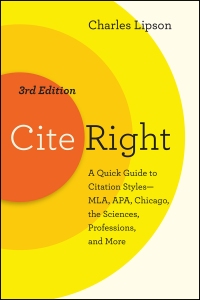by Summer Cowley

As an editor with editor friends, I find myself often reading works by authors who use citation styles other than the ones I regularly use in my own writing. Even though I become more comfortable with different styles every time I see them, many styles are unfamiliar in my APA-dominated world of the social sciences. Many times, I have wished there were an easier and more reliable way to quickly learn citation styles than running internet searches. Luckily, I’ve recently found Cite Right: A Quick Guide to Citation Styles—MLA, APA, Chicago, the Sciences, Professions, and More (2018) by Charles Lipson.
Cite Right is a short book (180 pages) in which Lipson provides summary explanations and examples of many citation styles. The book is divided into two general sections: “Citations: An Overview,” which contains introductory material and a general explanation of the practice of citing, and “Citations in Every Format: A Quick Guide,” which addresses Chicago/Turabian, MLA, APA, CSE, AMA, ACS, AIP for physics/astrophysics/astronomy, and mathematics/computer science/engineering citation styles.
This book is targeted toward students and writers who are novices to either the publication process or a particular citation style. The tone of the book is inviting and leans towards casual as the author advises writers to write citations that help the reader find information rather than “prance about showing off your knowledge without adding to the reader’s” (p. 4). Lipson informs the reader that Cite Right can be used as a reference for various citation styles currently in use, pointing out that each chapter is labelled by citation style and by the fields that commonly use that style. Although a wide variety of styles is represented, the list is not exhaustive. The Vancouver citation style, for example, is omitted from this book. However, this may be due to the inclusion of the AMA reference style, which (like Vancouver) is used in publications in the medical fields. Given that the two styles are highly similar and are used in the same field, it is possible that Lipson found them too similar to warrant the inclusion of both and chose the one more commonly used.
Lipson defines Chicago/Turabian, MLA, and APA as citation styles that the reader will likely have to use eventually and points out CSE, AMA, ACS, AIP, and various other styles as relevant to specific disciplines in the sciences. Lipson takes readers through the first section as a protective coach and guide, stating that the book will explain how to apply each style discussed so that “…you can concentrate on writing your paper, not on the type of citation you’re using” (p. 6). Throughout the introduction, he presents the basic goals of all citation styles and argues for basic citation-writing knowledge over using online citation generators (p. 7), defines and explains the use of hanging indents (p. 9), and explains the organization of the book and of each chapter (p. 10–11).
In the second section, Lipson introduces and explains each of the citation styles—one per chapter. Chapters 3 through 10 begin with a short introduction to the history and major reference works associated with each style. In the chapters dedicated to Chicago, MLA, and APA, he provides an index of the citation formats exemplified in each, so that the reader can easily flip to the right page when using the appropriate style for their work. This organizational set-up is highly welcome as it is consistent with Lipson’s advice to use the book as a reference manual rather than trying to memorize each citation format for each style. In every chapter in this section, bullet-point notes are provided (after each example of a citation format) that explain how the reader might alter the citation to apply to various circumstances.
Cite Right is a valuable resource for a varied readership. Secondary and post-secondary school instructors will find the book helpful as a resource when preparing lessons on the differences between various citation styles or on justifications for the use of citations at all. In chapter 11, Lipson addresses frequently asked questions about citing in general that may be particularly useful to instructors. Writers who must use a new citation style will also benefit from the ease with which this text can be read. For editors, this book is an invaluable tool for addressing issues of unfamiliar citation styles in authors’ work. Rather than searching through longer citation-style references, such as the APA manual or MLA Handbook, editors can refer to this guide to styles.
This book’s examination of the various citation styles allows readers to quickly identify an unrecognized citation style and to provide appropriate and helpful feedback on the author’s application of it. As such, this book is especially useful to editors who work with material from various fields and specialties. Additionally, editors will recognize when authors are using styles inappropriate for their field. With the addition of Cite Right to their reference libraries, editors will find themselves able to work confidently far beyond the most commonly encountered citation styles.
Summer Cowley has worked in writing centres across Canada and is currently a PhD student (Higher Education) at the Ontario Institute for Studies in Education, University of Toronto.
This article was copy edited by Vanessa Wells.
